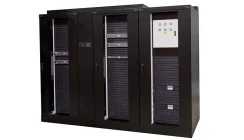The Role of Edge Data Centres in 5G Wireless Applications
Cisco predicts a tripling of digital traffic over the next five years, led by developments in Edge computing and the deployment of 5G wireless technologies. For data processing at the Edge, new types of datacentre are being developed which will also play a role in 5G (fifth generation) wireless connectivity.
What is a Micro Data Centre?
A micro data centre is a fully self-contained and managed environment, that is robust and relatively easy to deploy close to where data is generated and consumed by end users. The sole purpose of an MDC is to house the critical infrastructure required for Edge computing applications, Examples include streaming video services, financial services, retail operations, electricity capacity management and driverless electric vehicles (EVs).
An MDC is in effect a miniaturisation of a large datacentre and must be capable of providing comparable levels of computing performance, resilience and availability. Whilst a datacentre will look to serve a wider geographic area and end user customer base, an MDC is focused on smaller numbers of users and within a tighter geographic area.
The Advantages of a Micro Data Centre
Micro data centres, like modular data centres also offer speed of deployment and scalability advantages that traditional ‘bricks and mortar’ datacentres cannot provide as easily. As a self-contained computing environment or server room facility, the MDC may be housed within the same type of prefabricated container or cabin as a modular data centre or within a space within a fixed building.
The principle speed of deployment and scale advantages of an MDC come from its use of pre-engineered modules, components and systems. This approach allows an MDC to be built to meet a bespoke specification using ‘off-the-shelf’ products with some form of custom infrastructure configured for the final site. Standard products can include UPS systems and PDUs, server racks and IT/DCIM connectivity options as well as cooling systems and fire suppression systems.
As within a ‘bricks and mortar’ facility a modular or micro data centre provides critical infrastructure to deliver a resilient and suitable compute environment. These include critical power and cooling which can be customised to provide N+X resilience, battery runtimes, local energy storage and operating ambient. These systems are combined into a micro data centre as a single stack or operating unit.
As well as speed of deployment and scalability, micro data centre environments can also provide higher energy efficiency and especially when it comes to the energy consumed by the cooling system. Cooling one of the largest consumers of power within a datacentre environment. The self-contained micro data centre approach allows for the most efficient cool and hot air flows and therefore the most energy efficient cooing operation. The principles and advantages of hot and cold-aisle containment are evident within an MDC whose operating capacity, cooling requirements and power consumption can all be relatively easily calculated and controlled.
Critical Infrastructure Protection
As a self-contained unit a micro data centre takes advantage of prefabricated modules including racks, cabling, power distribution, cooling, fire suppression and security. All are designed to support and protect the critical IT infrastructure. Whilst an MDC could replace a server room or small datacentre within an organisation, their deployment in Edge computing and 5G applications requires some thought as to how they are to be housed.
An MDC can be housed within a standard steel ISO container. These are designed for ease of shipping by rail or road and can be 20 or 40foot in length. An MDC can also be housed in a purpose-built cabin or cabinet which is also designed for either inside a building or external deployment.
A critical element to consider for remote external deployment is the control of temperature and humidity. At the roadside level temperatures within a cabinet during an operational year in a climate such as the UK can be below freezing (down to as low as -15˚C) or as high as 40˚C or greater. The metal enclosure also needs to be built to a suitable IP standard, painted to the most appropriate paint specification for outdoor protection and made secure from unauthorised intrusion. The facility must also provide for ease of maintenance and service of the critical infrastructure systems.
Summary
Modular and micro data centres offer practical alternatives to what has become a traditional datacentre building. They both provide a standalone building shell which can be easily deployed and scaled to suite demand.
The rise of Edge computing and 5G applications will lead to a greater usage of modular and micro data centre type applications. Whilst modular data centres will continue to be deployed within recognised datacentre environments, the deployment of micro data centres could be more diverse in order to support Edge and 5G wireless applications. In much the same way as we recognise roadside fibre broadband cabinets, in the future the same may become true for micro data centres installed within their own type of cabinet.
For more information on Cisco and 5G visit: https://www.cisco.com/c/en/us/solutions/enterprise-networks/enterprise-mobility-trends-2019.html


























